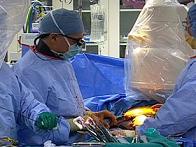|
From rxpgnews.com CTVS
A thoracic aortic aneurysm is the swelling or ballooning of the aorta, the largest artery in the body, which carries oxygenated blood from the heart. The thoracic aorta's diameter normally ranges from 1 to 1.5 inches. An aneurysm can cause it to grow several times its normal size. If not treated, the aneurysm can rupture, leading to internal bleeding which often is fatal. "The estimated mortality of a ruptured thoracic aneurysm is 90 percent for the first 48 hours," said Dr. Sadler. "Often, there are no symptoms, so most people won't know if they have an aortic aneurysm until it ruptures. Typically, they are detected when chest x-rays, CT scans or MRI tests are being obtained for other health problems. Approximately 40 percent of aneurysms in the aorta occur in the chest." The GORE TAG® endoprosthesis, developed by W. L. Gore & Associates, Inc., is the only Food and Drug Administration-approved thoracic endograft. The tube-shaped endovascular graft is comprised of a biocompatible ePTFE (expanded polytetrafluoroethylene) graft with an outer self-expanding nitinol (a combination of nickel and titanium) metallic support stent. During the procedure, Dr. Sadler will make small incisions in the patient's groin. Then the graft, which is compressed into the end of a long, thin, tube-like device called a delivery catheter, is guided up the leg artery, through the abdomen, into the chest, positioned inside the diseased section of the aorta and released, or deployed. The device self-expands to the inside diameter of the aorta, creating a tight fit and seal against the aorta wall. The graft re-lines the aorta, making a new path for blood flow. Once the graft is in place, a balloon catheter is used to profile the device -- a step that ensures the graft has achieved good compression and optimal diameter inside the aorta. The procedure usually takes 1 to 3 hours. Patients stay in the hospital for only a few days following the procedure and can return to normal activity within two to six weeks. All rights reserved by RxPG Medical Solutions Private Limited ( www.rxpgnews.com ) |
